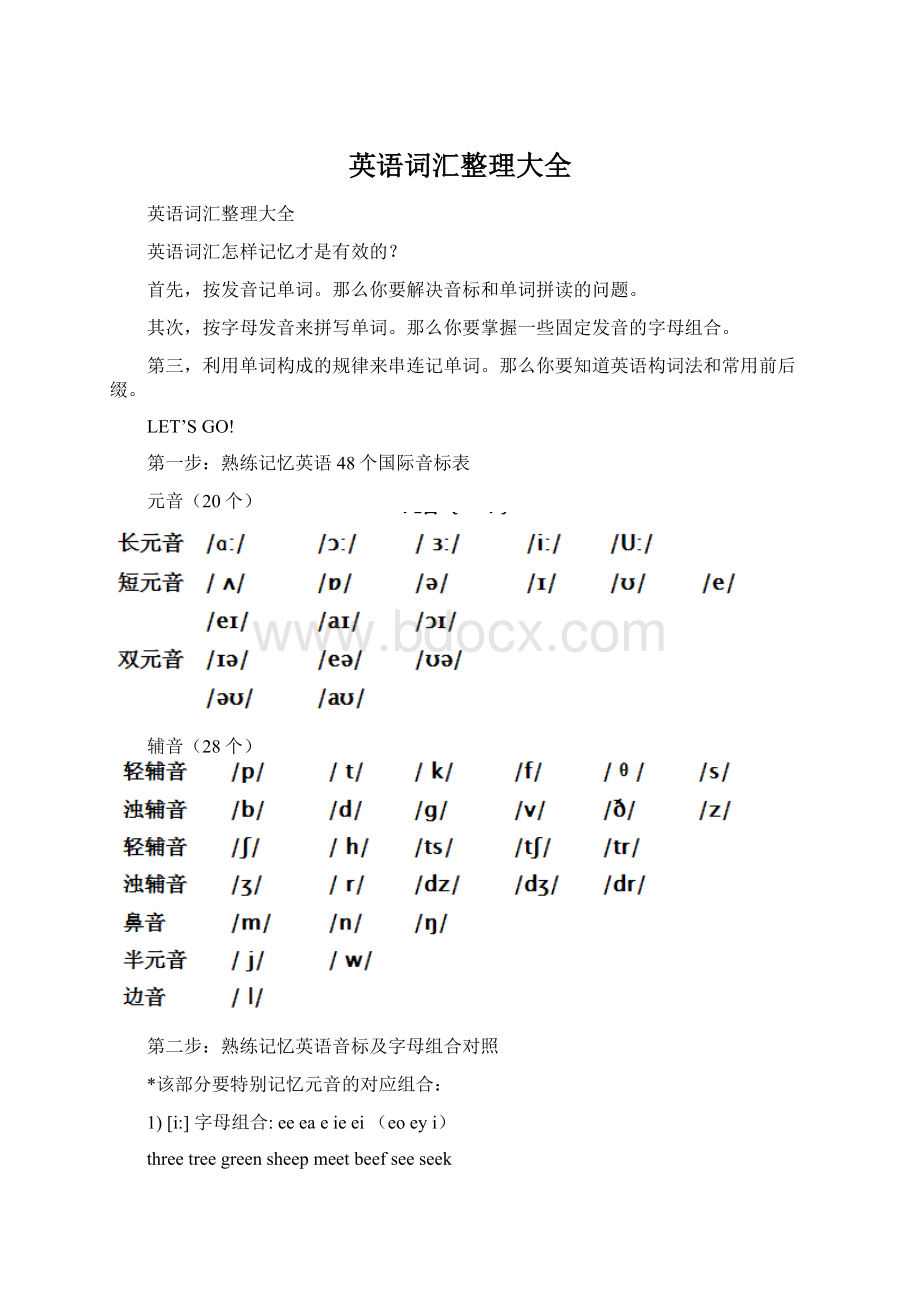英语词汇整理大全文档格式.docx
《英语词汇整理大全文档格式.docx》由会员分享,可在线阅读,更多相关《英语词汇整理大全文档格式.docx(17页珍藏版)》请在冰豆网上搜索。

workwormworkworld
6)[ε]字母组合erorouaroaeu
teacherleaderrememberplayerspeakerfarmerpowder
doctoractormayorauthortractor
deliciousgraciouspleasure
familiarcollardollar
togethertomorrowtodayshallotlessonWashingtoncontrolpolite
aroundaccountagoelephantmantabananaCanadaJapanchina
menlisten
famousSaturday
7)[a:
]字母组合ara
carfarmcardarmgarden
fastclasslastglassplantauntcalm
8)[ʌ]发音字母uoouoo
upsupperlunchfungunhuntcupbus
comemotherdosebrotherloveabove
troubleroughflourish
bloodflood
9)[ɔ:
]字母组合alorauourar
smallwalltalktallhallballcallwalk
shortmorelordhorseforfortysportdoorfloorstore
authorcaughtautumn
fourmourncourtbought
warmquarrelquarter
10)[ɔ]([ɒ])发音字母oaou
hotlostlotfoxboxmophoplosscollarnot
wantwashwatch
11)[u:
]字母组合ooou
foodmoonroomgloombroomdoomgoosetooth
shoedotwo
truetruthbluefullprude
12)[u]字母组合ooouuo
lookgoodfootbookwood
shouldcould
putfullbullpullpush
womanwolf
13)[ei]发音字母aayeaaiey
namecakelategateplaneApril
playsaymayway
greatbreak
rainpaintplain
theygrey
14)[ai]发音字母iy
bikefinefinddieninelightnighthigh
mytryflyeye
15)[au]字母组合ouow
houseoutflourgroundaccountcountsoundloudaroundmouse
flowerdownnowcowhowtown
16)[εu]发音字母oowoa
homecoldgonophonehostghost
knowlowbelowgrowblowshowflow
boatcoatgoal
17)[ɔɪ]字母组合oyoi
boytoyjoy oilsoilvoicechoice
18)[iε]字母组合eerear
beerdeerearnearherefierceidea
19)[ɛə]([eə])字母组合earairere
pearbearchairairfairtherewhere care
20)[uε][auə]字母组合ourowner
hourtour flowershower
第三步熟悉英语构词法
英语构词方法主要有三种:
即合成法、派生法和转化法。
1、合成法
将两个或两个以上的单词合成在一起而构成的新词,叫做合成词。
(1)合成形容词
①名词+现在分词
例:
English-speaking讲英语的,south-facing朝南的
②名词+过去分词
man-made人造的,water-covered被水覆盖的
③名词+形容词
snow-white雪白的,day-long整天的
④形容词+名词+-ed
warm-hearted热情的,kind-hearted好心肠的
⑤形容词/副词+现在分词
例:
good-looking好看的
funny-looking滑稽的
⑥副词+过去分词
well-known出名的,deep-set(眼睛)深陷的
⑦副词/形容词+名词
right-hand右手的,full-time专职的
⑧数词+名词
100-meter100米的,million-pound百万英镑的
⑨数词+名词+形容词例:
180-foot-high180英寸高的,10-year-old10岁的
⑩数词+名词+-ed
例:
four-footed/legged四脚的,one-eyed独眼龙的
(2)合成名词
①名词+名词
例:
weekend周末,classroom教室,bookshop书店
②形容词/介词+名词例:
gentleman绅士,loudspeaker扬声器
③动词+名词
typewriter打字机,cookbook烹调书
④名词+动词
daybreak破晓,toothpick牙签
⑤动词-ing形式+名词例:
reading-room阅览室,sleeping-car卧车车厢
⑥副词+动词
outbreak爆发,downpour倾盆大雨
⑦名词+动名词
handwriting笔迹,sun-bathing日光浴
⑧名词+in/to0+名词
mother-in-law岳母,brother-in-law姐夫
(3)合成动词
副词+动词
overthrow推翻,understand理解
②形容词+动词
broadcast广播,whitewash粉刷
③名词+动词
typewrite打字,sleepwalk梦游
(4)合成副词
介词+名词
underfoot脚下,beforehand事先
②形容词+名词
hotfoot匆忙地,someday有朝一日
③形容词+副词
anywhere任何地方,outwards向外、
(5)合成介词:
within在……之内,without没有,inside在……里边,into进入
(6)合成代词:
myself我自己,ourselves我们自己,anyone任何人,nobody没有人nothing没东西,somebody有人。
2、转化法
英语中,有的名词可作动词,有的形容词可作副词或动词,这种把一种词性用作另一种词性而词形不变的方法叫作转化法。
(1)动词转化为名词
很多动词可以转化为名词,大多意思没有多大的变化(如下①);
有时意思有一定变化(如下②);
有的与一个动词和不定冠词构成短语,表示一个动作(如下③)。
例如:
①Let'
sgooutforawalk.我们到外面去散散步吧。
②Heisamanofstrongbuild.他是一个体格健壮的汉子。
③Let'
shaveaswim.咱们游泳吧。
(2)名词转化为动词
很多表示物件(如下①)、身体部位(如下②)、某类人(如下③)的名词可以用作动词来表示动作,某些抽象名词(如下④)也可作动词。
①Didyoubookaseatontheplane?
你订好飞机座位了吗?
②Pleasehandmethebook.请把那本书递给我。
③Shenursedherhusbandbacktohealth.她看护丈夫,使他恢复了健康。
④Welunchedtogether.我们在一起吃了午餐。
(3)形容词转化为动词
有少数形容词可以转化为动词。
Wewilltryourbesttobetterourlivingconditions.我们要尽力改善我们的生活状况。
(4)副词转化为动词
有少数副词可以转化为动词。
Murderwillout.(谚语)恶事终必将败露。
(5)形容词转化为名词
表示颜色的形容词常可转化为名词(如下①);
某些形容词如old,young,poor,rich,wounded,injured等与the连用,表示一类人,作主语时,谓语用复数(如下②)。
①Youshouldbedressedinblackatthefuneral.你在葬礼中该穿黑色衣服。
②Theoldinourvillagearelivingahappylife.我们村的老年人过着幸福的生活。
3、派生法
所谓派生,即在词根上加前缀或后缀构成另一个与原意略有变化或截然相反的词。
(1)前缀
前缀通常只改变词义,不改变词性。
A.表示否定意义的前缀
1)纯否定前缀
a-,an-asymmetry(不对称)anhydrous(无水的)
dis-dishonest,dislike
in-,ig-,il,im,irincapable,inability,ignoble,impossible,immoral,illegal,irregular
ne-,n-none,neither,never
non-nonsense
neg-neglect
un-unable,unemployment
2)表示错误的意义
male-,mal-malfunction,maladjustment(失调)
mis-mistake,mislead
pseudo-pseudonym(假名),pseudoscience
3)表示反动作的意思
de-defend,demodulation(解调)
dis-disarm,disconnect,dislike
un-unload,uncover
4)表示相反,相互对立意思
anti-,ant-antiknock(防震),antiforeign,(排外的)
contra-,contre-,contro-contradiction,controflow(逆流)
counter-counterreaction,counterbalance
ob-,oc-,of-,op-object,oppose,occupy
with-withdraw,withstand
B.表示空间位置,方向关系的前缀
1)a-表示“在……之上”,“向……”例:
aboard,aside,
2)by-表示“附近,邻近,边侧”例:
bypath,bypass(弯路)
3)circum-,circu-,表示“周围,环绕,回转”例:
circumstance,circuit
4)de-,表示“在下,向下”例:
descend,degrade
5)en-,表示“在内,进入”例:
encage,enbed(上床)
6)ex-,ec-,es-,表示“外部,外”例:
exit,eclipse,expand,export
7)extra-,表示“额外”例:
extraction(提取)
8)fore-表示“在前面”例:
forehead,foreground
9)in-,il-,im-,ir-,表示“向内,在内,背于”例:
inland,invade,inside,import
10)inter-,intel-,表示“在……间,相互”例:
international,interaction,internet
11)intro-,表示“向内,在内,内侧”例:
introduce,introduce
12)medi-,med-,mid-,表示“中,中间”例:
Mediterranean,midposition
13)out-,表示“在上面,在外部,在外”例:
outline,outside,outward
14)over-,表示“在上面,在外部,向上”例:
overlook,overhead,overboard
15)post-,表示"
向后,在后边,次”例:
postscript(附言),
16)pre-,表示"
在前”在前面”例:
prefix,preface,preposition
17)pro-,表示“在前,向前”例:
progress,proceed,
18)sub-,suc-,suf-,sug-,sum-,sup-,sur-,sus-,表示“在下面,下”
subway,submarine,suffix,suppress,supplement
19)super-,sur-,表示“在…..之上”例:
superficial,surface,superstructure
20)trans-,表示“移上,转上,在那一边”例:
translate,transform,transoceanic
21)under-,表示“在…..下面,下的”例:
underline,underground,underwater
22)up-,表示“向上,向上面,在上”例:
upward,uphold,uphill(上坡)
C.表示时间,序列关系的前缀
1)ante-,anti-,表示“先前,早于,预先”例:
antecedent,anticipate,
2)ex-,表示“先,故,旧”例:
expresident,exhusband
3)fore-,表示“在前面,先前,前面”例:
forward,forecast,foretell(预言)
4)mid-,medi-,表示“中,中间”例:
midnight,midsummer
5)post-"
表示“在后,后”例:
postwar,
6)pre-,pri-,表示“在前,事先,预先”例:
preheat,prewar,prehistory
7)pro-,表示“在前,先,前”例:
prologue(序幕),prophet(预言家)
8)re-,表示“再一次,重新”例:
retell,rewrite
D.表示比较程度差别关系的前缀
1)by-,表示“副,次要的”例:
byproduct,bywork(副业)
2)extra-,表示“超越,额外”例:
extraordinary
3)hyper-表示“超过,极度”例:
hypersonic(超声波),hypertension(高血压)
4)out-,表示“超过,过分”例:
outdo(超过),outbid(出价过高的人)
5)over-,表示“超过,过度,太”例:
overeat,overdress,oversleep
6)sub-,suc-,sur-,表示“低,次,副,亚”例:
subeditor,subordinate,subtropical(亚热带)
7)super-,sur-表示“超过”例:
supernature,superpower,surplus,surpass
8)under-,表示“低劣,低下”例:
undersize,undergrown,underproduction(生产不足)
9)vice-表示“副,次”例:
vice-president,vice-chairman
E.表示共同,相等意思的前缀
1)com-,cop-,con-,cor-,co-表示“共同,一起”。
connect,combine,collect,combat,coexist,co-operate
2)syn-,syl-,sym-,表示“同,共,和,类”例:
symmetry,sympathy,synthesis(合成)
F.表示整个完全意思的前缀
1)al-表示“完整,完全”例:
alone,almost,
2)over-表示“完全,全”例:
overall,overflow(充满)
3)pan-表示“全,总,万”例:
panentheism(泛神论),panorama(全景画)
G.表示分离,离开意思的前缀
1)a-ab-,abs-,表示“分离,离开”例:
away,apart,abstract,abstain
2)de-表示“离去,处去”例:
depart,decolour,
3)dis-,di-,dif-,表示“分离,离开”例:
divorce,disarm(缴械)
4)ex-,e-,表示“离开,分离”例:
expel,exclude,expatriate(驱出国外)
5)for-表示“离开,脱离”例:
forget,forgive
6)re-表示“离开”例:
release,resolve
7)se-表示“分离,隔离”例:
separate,seduce,select
H.表示通过,遍及意思的前缀
1)dia-,表示“通过,横过”例:
diameter,diagram,
2)per-,pel-,表示“通,总,遍”例:
perfect,perform,pervade(浸透)
3)trans-,表示“横过,贯通”例:
transparent,transmit,transport
I.表示加强意思的前缀
a-例:
arouse,ashamed
ad-例:
adjoin,adhere(粘着)
J.表示变换词类作用的前缀
be-例:
befriend,
en-例:
enslave,enable,enrich
ad-,ac-,af-,ag-,an-,ap-,ar-,as-,at-
adapt,accord,affix,aggression,arrive,assist,attend,attract,arrange,assign(委派)
K.表示数量关系的前缀
1)表示“单一”,“一”
mon-,mon-例:
monotone(单调),monopoly,monarch
uni-,un-例:
uniform,unicellular(单细胞)
2)表示“二,两,双”
ambi-例:
ambiguous,amphibian(两栖类)
bi-,bin-,di-例:
bicycle,diode(二级管),
twi-例:
twilight
3)表示“十”deca,deco-,dec-deci-例:
decade,decimals
4)表示"
百,百分子一"
hecto-,hect-例:
hectometer,
centi-例:
centimeter
5)表示"
千,千分子一”kilo-例:
kilometer
6)表示"
万,万分子一”
myria-,myri-例:
myriametre
mega-,meg-例:
megabyte
micro-例:
microvolt(微伏特)
7)表示"
许多,复,多数”
multi-,mult-例:
multipmetre(万用表)multimedia,multinational
poly-例:
polysyllable,
8)表示“半,一半”
hemi-例:
hemisphere
semi-例:
semiconductor,semitransparent
pene-,pen-例:
peninsula
L.表示特殊意义的